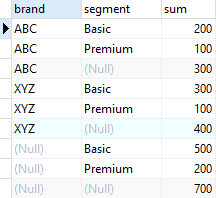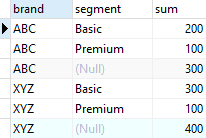Summary: in this tutorial, you will learn how to use the PostgreSQL CUBE to generate multiple grouping sets.
Introduction to the PostgreSQL CUBE
PostgreSQL CUBE is a subclause of the GROUP BY clause. The CUBE allows you to generate multiple grouping sets.
A grouping set is a set of columns to which you want to group. For more information on the grouping sets, check it out the GROUPING SETS tutorial.
The following illustrates the syntax of the CUBE subclause:
SELECT
c1,
c2,
c3,
aggregate (c4)
FROM
table_name
GROUP BY
CUBE (c1, c2, c3);In this syntax:
- First, specify the
CUBEsubclause in theGROUP BYclause of theSELECTstatement. - Second, in the select list, specify the columns (dimensions or dimension columns) which you want to analyze and aggregation function expressions.
- Third, in the
GROUP BYclause, specify the dimension columns within the parentheses of theCUBEsubclause.
The query generates all possible grouping sets based on the dimension columns specified in CUBE. The CUBE subclause is a short way to define multiple grouping sets so the following are equivalent:
CUBE(c1,c2,c3)
GROUPING SETS (
(c1,c2,c3),
(c1,c2),
(c1,c3),
(c2,c3),
(c1),
(c2),
(c3),
()
)In general, if the number of columns specified in the CUBE is n, then you will have 2ncombinations.
PostgreSQL allows you to perform a partial cube to reduce the number of aggregates calculated. The following shows the syntax:
SELECT
c1,
c2,
c3,
aggregate (c4)
FROM
table_name
GROUP BY
c1,
CUBE (c1, c2);PostgreSQL CUBE examples
We will use the sales table created in the GROUPING SETS tutorial for the demonstration.
 The following query uses the
The following query uses the CUBE subclause to generate multiple grouping sets:
SELECT
brand,
segment,
SUM (quantity)
FROM
sales
GROUP BY
CUBE (brand, segment)
ORDER BY
brand,
segment;Here is the output:
 The following query performs a partial cube:
The following query performs a partial cube:
SELECT
brand,
segment,
SUM (quantity)
FROM
sales
GROUP BY
brand,
CUBE (segment)
ORDER BY
brand,
segment; In this tutorial, you have learned how to use the PostgreSQL
In this tutorial, you have learned how to use the PostgreSQL CUBE to generate multiple grouping sets.